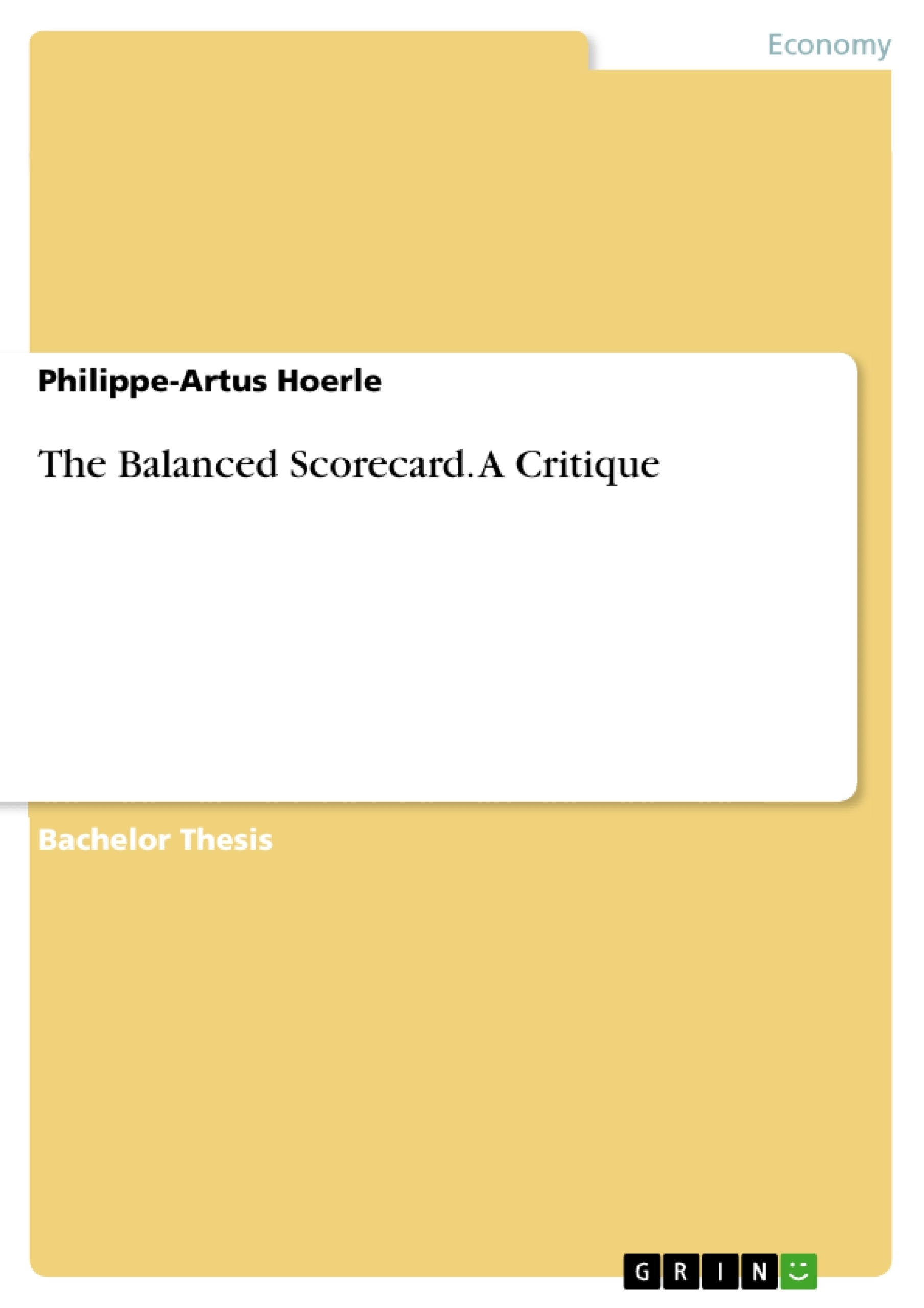In today’s business environment measuring business performance is a matter of life and death within any organisation (compare Ittner and Larcker, 1998). Due to the changing nature of work and increasing competition with changing demands (Neely, 1999) the number of people interested in business performance measurement has recently increased dramatically. But business performance measurement is confronted with a vital choice what system the company should use to quantify the success of the organisation’s strategy. In this context the Balanced Scorecard(Kaplan and Norton, 1992, 1996) is almost used as a synonym for measuring
Business Performance Measurement (BPM). With this in mind, the following dissertation aims at a critical exploration and
assessment of the framework of the Balanced Scorecard (BSC) and it examines if this framework merits its wide popularity experienced and still experiences.
Following a definition of the BSC, the author turns to the elements of the BSC with its key proclamations. Strengths and weaknesses will be outlined by considering different case scenarios. The main attention will be put on the question whether the BSC leads to better business results, as it is publicized, or if its wide use is only an outcome of its effective promotion.
Before the analysis comes to an ending in which it summarises the key points, the author suggests some recommendations for organisations when using the BSC, in order to meet its problem areas. In this context the author’s personal view will be
flowing in.
Inhaltsverzeichnis (Table of Contents)
- Abstract
- Table of Contents
- Table of Tables and Figures
- Acknowledgements
- Introduction
- General Introduction into the Topic
- Evolution: Financial vs. Non-Financial Measures
- Total Quality Management
- Popularity of the Balanced Scorecard
- Aim of the Dissertation
- Structure of the Paper
- Methodology
- Research Approach
- Research Design
- Contribution of Researcher
- Data Collection
- Primary Research
- Secondary Research into Existing Literature on the Balanced Scorecard
- Part I - Origins of the Balanced Scorecard
- 1.1 Development of the Balanced Scorecard
- 1.2 Kaplan and Norton's Use of "Success Stories"
- Part II - Key Points of the Balanced Scorecard
- 2.1 Analysis Balance
- 2.1.1 Balanced Focus Possible?
- 2.1.2 Barriers for Balance
- 2.2 Analysis Cause and Effect
- 2.2.1 Analysis Strategy Map
- 2.2.2 Co-Variation
- 2.2.3 Calculating Style
- 2.2.4 Macro Environment: Barrier for Cause and Effects
- 2.2.5 Causes Rather Merely the Effects...
- 2.3 Analysis: Customer Value
- 2.3.1 Critique
- 2.3.2 Customer Value Equal Profitability?
- 2.4 Analysis Proposed Perspectives
- 2.4.1 Additional Stakeholders
- 2.4.1.1 Lack of Attention to the Competition
- 2.4.2 Questionable Learning and Growth Perspective
- 2.4.3 Employee Perspective
- 2.5 Analysis Measures
- 2.5.1 Danger: Over-Measurement
- 2.5.2 Milestones
- 2.5.3 Risk of Imitation
- 2.6 Analysis Strategy Part
- 2.6.1 Framework Strategy
- 2.6.1.1 Is It Possible to Formulate Strategies with a Framework?
- 2.6.2 Strategic Planning
- 2.6.3 Non-Tailored Strategy
- 2.7 Analysis: Adding Value with the Balanced Scorecard?
- 2.7.1 Porter's Value Chain and the Balanced Scorecard
- 2.7.2 Differences
- 2.8 Analysis: Implementation of the BSC
- Part III Recommendations regarding use of BSC
- 3.1 Situational Analysis
- 3.1.1 When are Strategies Good?
- 3.1.2 Decision Period
- 3.2 Strategy Review and Adaptation-Situational Analysis
- 3.2.1 Upshot
- 3.3 Measuring the Right Things Right
- 3.4 Vision Formulation
- 3.5 Communication
- 3.6 Upshot
- 3.6 Hoshin Kanri and the Balanced Scorecard
- Part IV Why this popularity of the BSC?
- Conclusion
- Further Issues
Zielsetzung und Themenschwerpunkte (Objectives and Key Themes)
This dissertation critically examines the Balanced Scorecard (BSC) framework and its widespread popularity in business performance measurement. It aims to analyze the strengths and weaknesses of the BSC, considering various case scenarios, and assesses whether it genuinely leads to improved business results or simply benefits from effective promotion.- The origins and development of the Balanced Scorecard.
- Key aspects of the Balanced Scorecard, including its balance, cause and effect analysis, customer value perspective, and proposed measures.
- The implementation and application of the Balanced Scorecard within organizations.
- The reasons behind the Balanced Scorecard's popularity, considering both its potential benefits and limitations.
- Recommendations for effective use of the Balanced Scorecard in addressing its weaknesses and optimizing its application.
Zusammenfassung der Kapitel (Chapter Summaries)
- The introduction provides an overview of the dissertation's focus on the Balanced Scorecard framework and its popularity in measuring business performance. It highlights the changing nature of work and increasing competition in today's business environment, emphasizing the importance of effective performance measurement systems.
- The methodology section describes the research approach and design employed, outlining the data collection methods and the researcher's contribution. It includes both primary and secondary research, with a focus on existing literature on the Balanced Scorecard.
- Part I delves into the origins of the Balanced Scorecard, examining its development and how Kaplan and Norton utilized "success stories" to promote its adoption.
- Part II dissects key aspects of the Balanced Scorecard, analyzing its focus on balance, cause and effect analysis, customer value perspective, and proposed measures. It critically assesses the framework's strengths and weaknesses, examining potential barriers to its successful implementation.
- Part III provides recommendations for effectively utilizing the Balanced Scorecard within organizations. This includes considerations for situational analysis, strategy review and adaptation, measuring the right things, vision formulation, communication, and the integration of Hoshin Kanri principles.
Schlüsselwörter (Keywords)
This dissertation explores the concept of the Balanced Scorecard (BSC) in business performance measurement. It examines the framework's strengths and weaknesses, analyzing its balance, cause and effect relationships, customer value perspective, and proposed measures. The dissertation also investigates the reasons behind the BSC's popularity, including its perceived benefits and potential limitations. Key topics include performance measurement, strategic management, organizational effectiveness, and the role of frameworks in achieving desired business outcomes.- Quote paper
- Philippe-Artus Hoerle (Author), 2005, The Balanced Scorecard. A Critique, Munich, GRIN Verlag, https://www.grin.com/document/134684



